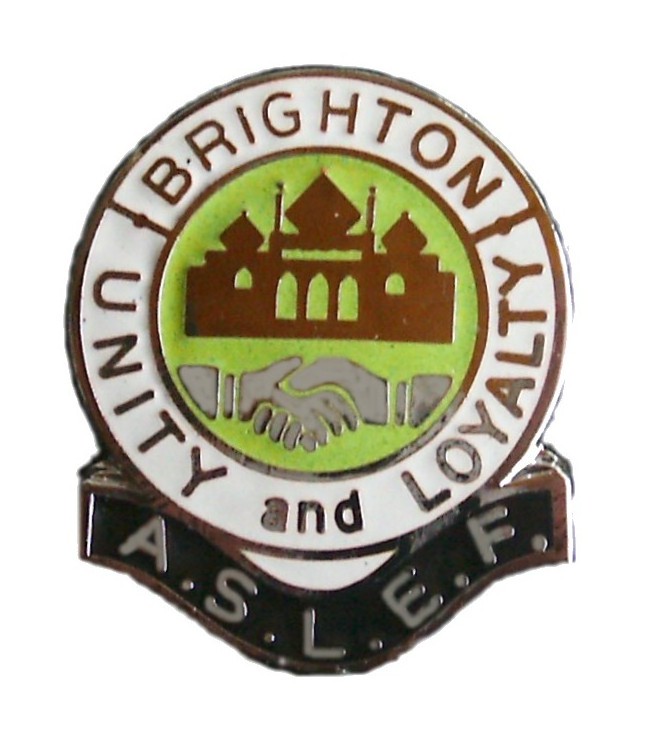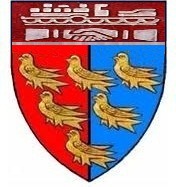BRICKLAYERS ARMS JUNCTION
11th SEPTEMBER 1975
INVOLVING
Front loco 33041
Norwood Driver Dave Park & Secondman Paul Collins
Rear loco 33047
Norwood Driver Terry Wiltshire & Secondman Clive Collins.
EMUT Driver R.W. Williams depot unknown
extracted and adapted from the report by
A.G.B. KING MAJOR
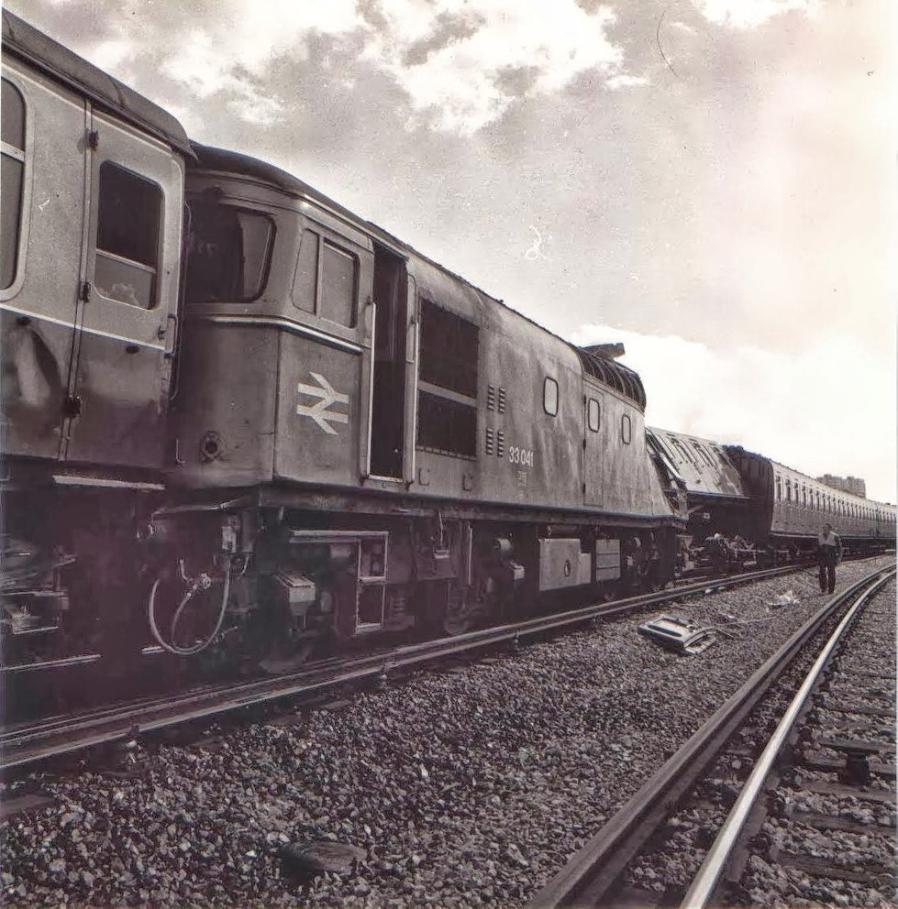
PHOTOGRAPHER UNKNOWN
On the 11th September, 1975 a collision between a passenger train and an empty coaching stock train occurred at 09.43 at
Bricklayers Arms Junction in the Southern Region. As the 09.02 electric multiple unit passenger train from Epsom Down to
London Bridge was travelling under clear signals from the up slow line to the reversible line at Bricklayers Arms Junction, it
collied at between 20 -25 mile/h almost head on with the diesel locomotive hauling the 09.42 empty coaching stock train from
London Bridge to New Cross Gate Carriage Sidings. The empty coaching train had been brought to a halt by its driver on seen
the approach of the electric train after he had passed a multiple aspect colour light signal at danger, under the impression that the
subsidiary signal position light signal was exhibiting a proceed aspect.
The emergency services were rapidly alerted both by the signalling staff at London Bridge signal box and by witness of the
accident. The collision blocked the reversible and the down and up spur lines and discharged the 750 DC traction current; in
order to evacuate the injured and other passengers and staff from the site and to allow clearance work to be undertaken, current
was also discharged from the up and down fast and slow lines which were closed, trains being stranded over a wide area.
The majority of the 82 passengers and railway staff who were injured suffered only minor injuries or shock; 9 were detained in
hospital but of these only 2, both members of railway staff, wee kept there beyond the following day. The down fast and slow
lines were re-opened at 11.22 followed by the up fast and slow lines at 14.45 and the remaining lines were re-opened at 21.30
on the 11th September.
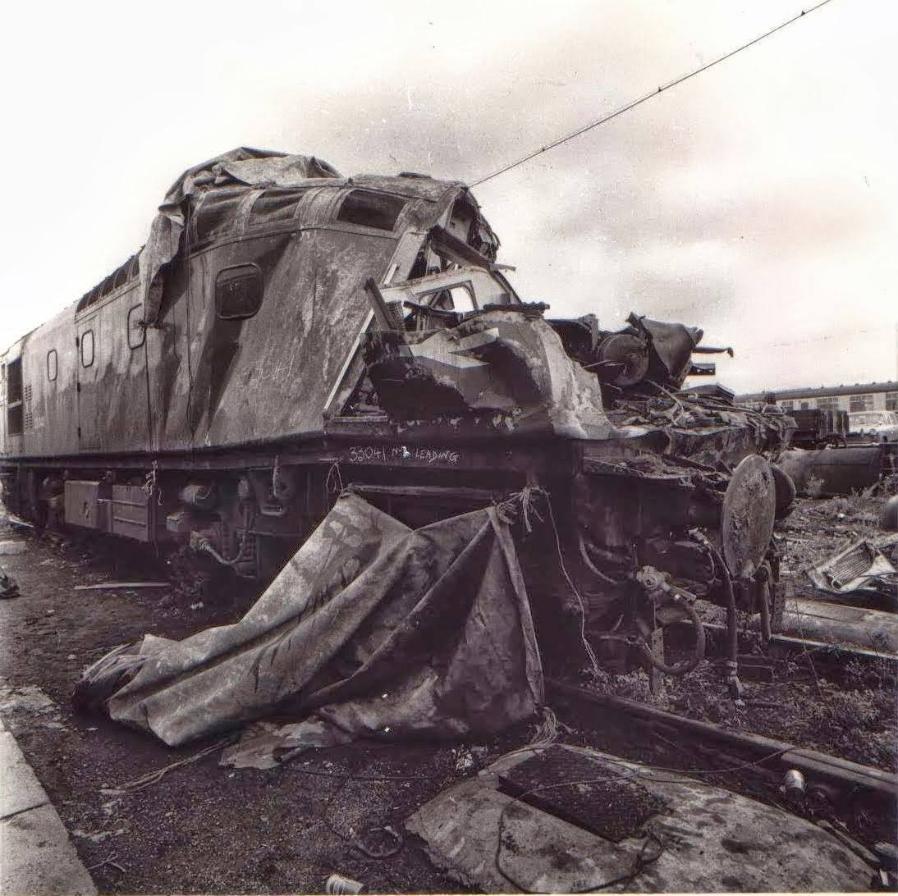
PHOTOGRAPHER UNKNOWN
Description
Site
1 To the north of New Cross Gate station, travelling in the up direction towards London Bridge, there are four lines of railway,
with up lines on the west side. At Bricklayers Arms Junction, where there are crossovers between the up and down fast and slow
lines, the lines towards London diverge to run on three separate formations, with the up and down goods lines to the left leading
from the up slow line to North Kent West down a falling gradient; to the right up fast and down fast and slow lines continue
curving to the right on a slightly rising gradient towards Blue Anchor; and on the centre formation curving to the left before
becoming straight on a rising gradient of 1 in 162 steepening to 1 in 106, the up slow line becomes the up spur line and there are
connections from the up fast and up slow lines to the down spur line and reversible line which lie to the east of the up spur line.
The collision occurred where the connection from the up slow (up spur) line joins that from the up fast and lines then divide to
become reversible and down spur lines. At the point of collision the spur and reversible lines lie approximately south east to
north west and are running on an embankment some 20 - 30 feet above land containing factories, houses and playing fields.
Normal line speed over the spur, reversible and up slow lines is 60 mile/h; over the diverging route at a set of points the speed
limit is 25 mile/h.
The Signalling
2 In the area of Bricklayers Arms Junction trains are signalled under the tract circuit block regulations using equipment which
was commissioned in July 1975 controlled from a standard British Railways entrance - exit panel at London Bridge signal box
through a micro core link to a local relay room at New Cross Gate which contains and safety interlocking equipment. Four
aspect colour light running signals are used with theatre type route indicators for slow speed routes and junction indicators for
higher speed routes. Shunting and subsidiary signals are of the position light type with theatre type route indicators where
necessary; when mounted independently they display a red and white aspect for danger and two white aspect for proceed,
mounted in conjunction with a main running signal they are normally not illuminated and for a proceed aspect display two white
aspects at 45 degrees. Points machines are electrically operated with AC detection circuits. All the lines are fully circuited and
electrified on the Southern Region standard 750v DC system. As its name implies the reversible line is signalled and equipped
for movement in either direction.
3 Bricklayers Arms Junction is protected by signals L543 on the reversible and L545 on the down spur line. Both are mounted
on a right hand bracket with the red aspect of signal L545 16 feet 6 inches above, and 3 feet to the left of, the left hand running
rail. As they control slow speed movement they are equipped with theatre type route indicators each displaying two routes.
Signals L543 and 545 are provided with a shared overlap of 174 yards towards the connections at Bricklayers Arms Junction
and reduced overlaps of 47 and 49 yards respectively for movements over the common section beyond No.965 points. To the
right of each of the bottom (red) aspects a subsidiary signal is provided with its centre 2 feet to the right of the main signal red
aspect. These control movements from the lines concerned into the 2 carriage road lines at New Cross Gate. The illumination of
position lights subsidiary signal L545 is approach controlled by the occupation of a track circuit commencing 360 yards in rear
of it. Signal L545 is 174 yards from the point of collision.
4 The signals controlling movements towards Bricklayers Arms Junction on the up slow lines are L556 and L552. Signal L556
is at the north end of the platform at New Cross Gate on the upright supporting a signal over the up fast line. To the left of its
bottom (red) aspect is mounted a subsidiary signal controlling movements into the carriage roads from the south. Signal L552 is
the signal immediately protecting the junction and has a 3 position junction indicator; it is mounted at the top of the upright
supporting s bracket for another signal, immediately to the left of the bottom (red) aspect of signal L552 is a subsidiary signal
controlling movements onto the up goods line. Signals L556 and L552 are respectively 1302 yards and 597 yards from the point
of collision; their overlaps are normally respectively 322 and 232 yards but signal L556 has a reduced overlap of 181 yards. All
signals are equipped with signal post telephones. On the parapet wall beside the reversible line there are two lights showing in
both directions as a warning to staff working on the track. One white light is illuminated when an up train is signalled over the
reversible line and two when a down train is signalled.
5 In London Bridge signal box the entrance exit route setting panel has a separate line diagram mounted vertically above and
behind it. When a signalman wishes to set a route forward from a signal he presses the entrance button and a flashing white light
appears at its base, he then presses the exit button at the end of the route and, provided the route is available and can be set, a
row of white lights appears on the display panel along the route and the indication for the signal aspect changes from red to
green indicating that a proceed aspect is being displayed. Different indications are not given for green, single, and double
yellows aspects but there are separate indications for main and subsidiary signals. Where there are alternative overlaps for a
signal an exit button is provided at each overlap point and, for instance, when a route is to be set from signal L537 which is the
signal preceding signal L545 and the full overlap is not available in advance of signal L545 then the reduced overlap exit button
is pressed, and the clearance of signal L537 is approach controlled to ensure that the speed of the train has been reduced prior to
it entering the route. When the full overlap is available then the clearance of signal L537 is not under control AWS is not yet
provided on the lines concerned. The staff warning lights referred to are repeated on the diagram and in addition, an arrow on
the diagram is illuminated to indicate in which direction a train is signalled over the reversible line.
The Trains
6 the 09.42 locomotive hauled empty coaching stock train from London Bridge to New Cross Gate carriage sidings (5D33)
consisted of locomotive No. 33041 hauling 8 gangway vestibuled coaches and (trailing at the London end) locomotive No.
33047. This train had a tare weight of 424 tons 10 cwt and a overall length of 632 feet. This formation is adopted to remove the
train locomotive with the coaching stock from the terminal platforms in order to avoid two separate movements out of the
station. The two locomotives were both built in 1961 and were of identical construction. The coaches were built of the BR Mk 1
design between 1953 and 1962. They were of all steel design with Buckeye couplers and Pullman gangways and 2 pipe air
braking was in use. The 09.02 Epsom downs to London Bridge (2H27) consisted of British Railways class 405/2 4 car suburban
unit (4 SUB) electric multiple unit (EMU) No. 4704. This train had a tare weight of 132 tons 4 cwt and an overall length of 257
feet 5 inches over buffers. The underframes of the 2 motor coaches (end vehicles) of the EMU were built in 1925 and converted
to their present form in 1950 the bodies being built at the same time. One of the trailer coaches (centre vehicles) was built in
1929 and then rebuilt in 1950 with a body built at the same time and the other was built in 1947. All steel frames with sheet
steel cladding and the coaches were permanently coupled together with centre buffers and 3 link coupling. The unit was fitted
with Westinghouse automatic air brakes.
The Course of the Collision and the Damage Caused
7. Having brought his train to a stand on the down spur line at Signal L545 the driver of 5D33, under the impression that the
subsidiary signal was exhibiting a proceed aspect for his movement to the carriage road, released the brakes and moved his train
forwards. Almost immediately he became aware of the approach of 2H27 which was travelling towards him on the up slow line
and then proceeded to cross his route from his right hand side in order to gain the reversible line. He applied the brakes, and
with his secondmen evacuated the cab by the side doors; the train was almost at a stand when a glancing head on collision
occurred. The driver of the EMU also made an emergency brake application when he saw the diesel locomotive coming towards
him but could do no more than to reduce the speed of his train before the collision. the two trains met at a slight angle which
result in the leading coach of the EMU being lifted up and pushed past the locomotive, coming to rest leaning over at an angle
with the passenger accommodation effectively intact. The cab of the locomotive and that of the EMU were completely
destroyed by impacting into one another. The front of the EMU was pushed back into the guard’s van, the buffer beam was bent
approximately at right angles from the mid point, and the under frame rode up over the locomotive frame allowing the
locomotive buffer beam to push the motor bogie back to a point near the trailing bogie. The under frame equipment of the
leading motor coach was extensively damaged but the remaining three coaches of the EMU were effectively undamaged. The
front of the leading locomotive was pushed back approximately 15 ft and considerable damage was caused to the leading end of
the engine compartment. Both sole bats were bent, the air pipes, conduits and brake gear of the bogies were damaged, and the
headstock at the leading end was badly bent. All the front fittings were severely damaged and the buffers were torn off. The rear
end of the leading locomotive and the front of the leading coach of the train were slightly damaged where they had impacted
and this had resulted in the leading bogie of the leading coach being derailed. The remaining coaches and the trailing
locomotive of the empty coaching stock train were effectively undamaged.
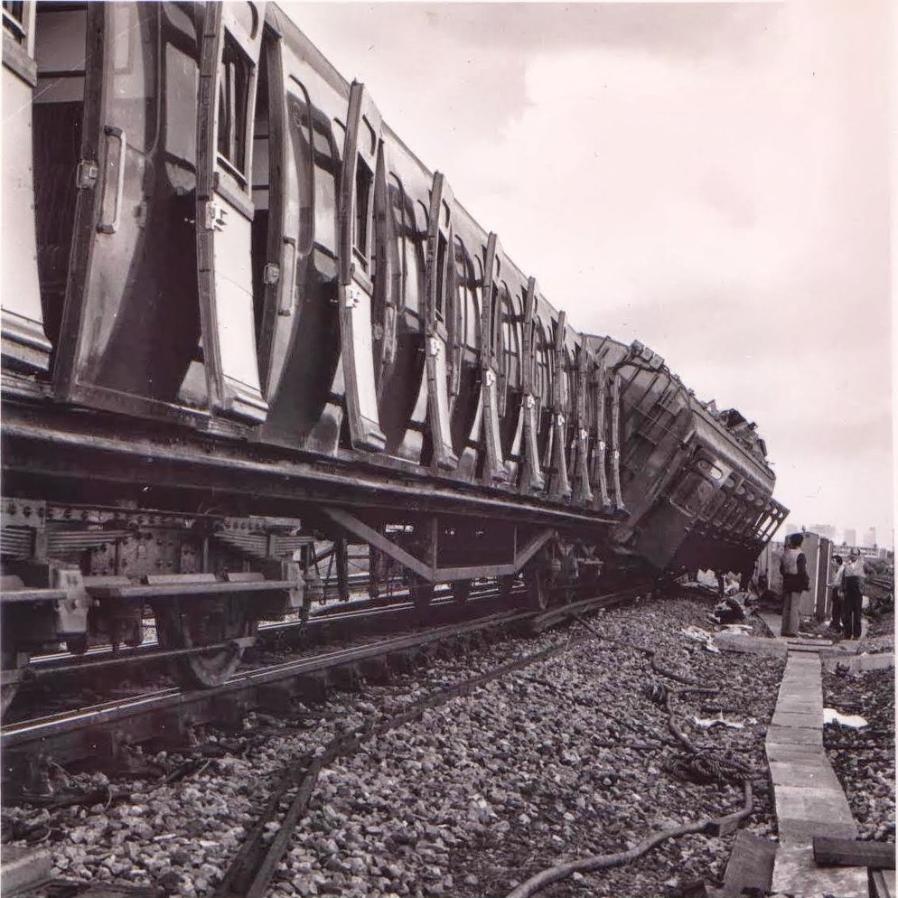
PHOTOGRAPHER UNKNOWN
EVIDENCE
8 Area Inspector D. Mutton was on duty on a 12 hour shift in London Bridge signal box on the day of the accident supervising
signalmen in their training which he had been doing since the signalling was commissioned on 27th July 1975. He told me there
were two panels numbers 8 and 9 in use, the latter controlling the terminal part of the station. One signal was appointed to each
of the two panels and because of the newness of the work and the pressure, a third man was allocated to act between them. The
areas in which they worked were not closely laid down and the panel was split up between the men as they liked. There was no
objection to their overlapping or to one signalman setting a route in that part of the panel controlled by another signalman since
the safety interlocking only permitted safe routes to be set and only one route could be set at a time. At about 09.45 he notice
signalman Thomson turning round whilst speaking on the telephone and then saying, while pointing to the panel display, “that
train up there has collied with that train there and they want ambulance.” He arranged for the alerting of the emergency services
and then with the aid of the signalmen supervise the isolation of the traction current, and arranged for the safe detraining of the
passengers. After the accident he noticed that the two carriage road lines were indicated as being occupied, and this meant to
him that the empty coaching stock train must have been held at signal L545. He also noticed that signal L545 was indicated as
being at red and there was no indication that the subsidiary signal was exhibiting a proceed aspect. Points No.965 were lying
normal which meant that they were set for a route along the reversible line. The train describer display showed 5D33 in the
berth of signal L545 and 2H27 was in the display on the reversible line. Immediately after the accident all the entrance buttons
were pulled out in order to put all signals to danger.
9. Mr. Mutton told me that the booked working for 2H27 was via the up spur line but that since the reversible line has a clear
run into platform No.12 in which the train was due to terminate, the signalmen may route the traffic as circumstance permit and
in this case they acted quite correctly in routing the passenger train as they did. He could not remember there having been any
failures of signals L545, L552, or L556; nor had he heard any complaints in respect of the sighting of those signals from drivers
and could not recall any occasions when drivers had telephoned on the signal post telephones to query whether a signal was
exhibiting a proceed aspect or not. Later on, after the accident, a driver did telephone from a signal, probably L554, and asked
the signalman to tell him whether the subsidiary position light signal was exhibiting a proceed aspect because the sun was
shining on the gantry, but up until that time he had no knowledge at all of drivers telephoning about this problem.
10. Signalman H.J. Floyd was on duty on No. 9 panel on the morning of the accident. He told me that he cleared the signals for
5D33 which although due to leave at 09.42 actually left at 09.38, he then discussed with signalman Chick the running of 2H27
on the reversible line to avoid a conflict with a train proceeding on the up south London line. He told me that he actually asked
signalman Chick to let the Epsom travel on the reversible line and that replied all right. The last exit button which he was for
5D33 was that by signal L511 and the train was travelling on its booked route. When he heard that there had been an accident he
replaced the signals for a train which was just about to depart from London Bridge but apart from that he had not had any
occasion to alter or reverse any signals that day. He told me that he had been in the old London Bridge signal box for 3 years
and had moved into the new signal box when it was first commissioned. He could not recollect drivers expressing difficulty in
seeing signal aspects, nor could he remember an occasion when a driver had telephoned him and asked whether or not a signal
was showing a proceed aspect.
11. Signalman E.T. Thomson, who was in charge of No. 8 panel told me that the trains were running nearly on time and that he
had discussed with the signalman in the middle and the man on No. 9 panel which way they should run 2H27. All three had
agreed that it should travel in the up direction on the reversible line so he signalled the train in that way using the entrance
button on signal L552 and the exit button on signal L536. Although he had originally said that both the carriage road lines were
empty, upon reflection he was sure that they were occupied, consequently the intention was to detain the empty coaching stock
train on the down spur line. At about 09.44 there was a telephone call from signal L547 on the goods lines and someone who
described himself as secondman on the empties on the down spur line said “we’ve run into the up passenger train, we thought
we had the signal, can i go now to help get the people out.” He said that after telling the secondman that he could do so he
turned around and asked for the emergency services and, when the current was cut off over the whole area, carried on answering
the telephone when drivers rang up because they had lost traction current.
12. He told me that after the accident he noticed that the routes were correctly set for both trains; that for 5D33 from signal
L537 on the down south London line on the reduced overlap to signal L545 on the down spur line. For 2H 27 the route lights
were illuminated on the panel from a position in advance of signal L552 onto the reversible line. The train description 5D33 was
in the berth of signal L545 and that of 2H27 was in a berth on the reversible line. Since it had been accepted that 2H27 would
run up the reversible line he did not line he did not think that another signalman would have attempted to set a conflicting
movement for 5D33 because the interlocking would not permitted it. He was quite certain that the reduced overlap button at
signal L545 had been pressed by the other signalman because the normal overlap would become occupied by 2H27. he could
not remember which of the two trains had been signalled first, but it was only possible to set one route at a time. he had not
received any official complaints from drivers who found difficulty in seeing the proceed aspect of the subsidiary signal L545 but
he had talked to drivers who had said they did not like the new type signal hoods compared with the old ones.
13. working between panels 8 and 9 in what is known as the middle mans position was signalman G.W. Chick who said that he
set the route for 5D33 from signal L537 using the reduced overlap button at the latter signal because it had been agreed that
2H27 would travel over the reversible line. He could not remember which train had been signalled first, but he would have
signalled the empty coaching stock train right through to the carriage sidings at New Cross Gate because they had stock in them.
He was sure that he had used the reduced overlap button at signal L545 because to use the normal over lap button would have
resulted in attempting to signal conflicting movements. Immediately after signalman Thomson said that there had been an
accident he replaced all the signals in the area to danger but before that he had not had any occasion to set a route and then to
cancel it. He had worked in the signal box for about 10 days when the accident happened. He knew that the approach locking
prevented him reversing a signal and then changing the route in the overlap of that signal before a time release of two minutes
had operated.
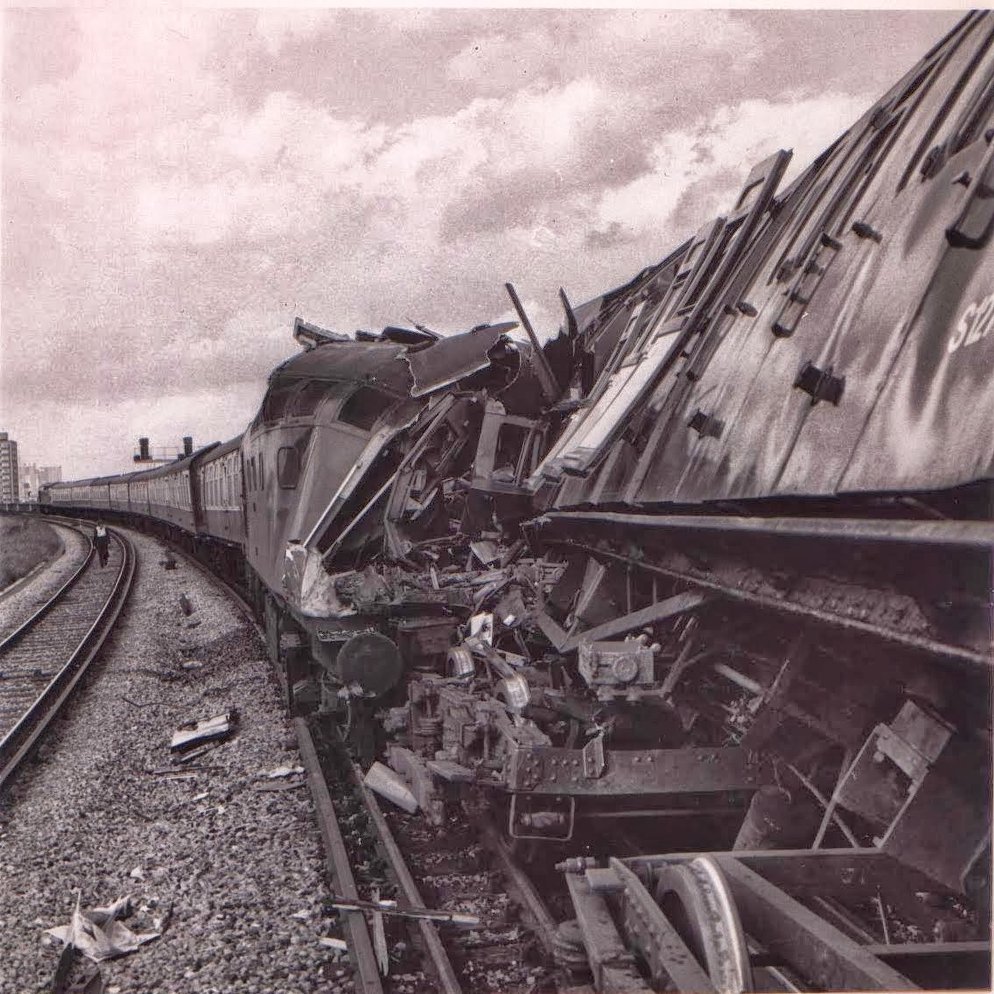
PHOTOGRAPHER UNKNOWN
As to the running of the trains
14. Because of his injuries I was unable to interview driver R.W. Williams, the driver of 2H27, until 17th October when I saw
him at home with his leg in plaster in the company of his union representative. He told me that he left New Cross Gate normally
and thought that there had been a single yellow aspect in signal L556 and that on approaching Bricklayers Arms Junction he had
seen a double yellow aspect in signal L552. Because there are 4 car gaps in the conductor rail near the old signal box he was
allowing his train to coast at about 30 mile/h when he saw the other train coming towards his line; after ascend or so he made a
full emergency Westinghouse brake application, let go of the DSD, realised that he could not stop short of the other train and
that his side of the can would get the worst of any impact, and went over to the other corner; he believed he had sounded the
horn but was not certain. he thought that about 6 seconds elapsed between his brake application and the collision and the next
thing he remembered was regaining consciousness in his cab and being trapped by his legs.
15. in charge of 2H27 was guard T. Martin who remembered giving the ready to start signal with a green flag at New Cross Gate
station while the starting signal at the end of the platform was showing a single yellow aspect. He looked out of the brake van
window to check his train as it drew away but withdrew his head and did not look out again until the collision ocurred. He did
not recollect the brakes being applied before the collision and thought that his train was travelling at about 25 mile/h, the normal
kind of speed that it would have been doing in the Bricklayers Arms Junction area. He was unable to protect the train after the
collision because he was injured, but he was assured by a permanent way man that this had been done.
16. in the leading cab of the locomotive at the rear of 5D33 was driver T.G. Wiltshire who had driven a train from East
Grinstead to London Bridge, the empty stock of which then became the train involved in the accident. The main controller of
the locomotive was in the OFF position and the engine was not running so that his locomotive was being towed as part of the
train. After the front locomotive had been attached to the train at London Bridge he remembered the train starting and having a
very slow journey, its driver applying the brakes presumably at signal checks, until they came to a stand at signal L545 where he
estimated that they stood for at least half a minute. The train then moved forward again and had gone 4 or 5 coach lengths when
there was an emergency brake application and almost at the moment at which the train came to a stand he felt the impact of the
collision. He jumped out of the cab and ran forward on the right hand side of his train but did not look at any of the signals on
the way. on seeing the leading locomotive he realised that if the driver and secondman were still inside he could not help them.
He obtained a short circuiting bar which he put on the up spur line, went t a brake van in the EMU and took the emergency tools
from it, and helped to free the driver of the EMU from his cb. He did not carry out protection of any of the trains involved. The
driver of the EMU told him “I definitely had two yellows on that last signal” while the driver of the train to which his
locomotive was attached told him “I definitely had the two white lights.”
17. The secondman of the leading locomotive of 5D33 was Secondman P.G. Collins. He had booked on at 05.25 and then
travelled with a light locomotive to East Grinstead to work the 08.02 London Bridge where the locomotive had been detached
from the train and then coupled to the rear of a train to work it as 5D33 to New Cross Gate carriage sidings. He told me that
after setting off from London Bridge they travelled normally and he thought that their speed would have been about 20 mile/h.
He remembered seeing a single yellow aspect and junction indicator at signal L537 but could not remember whether or not the
signal had cleared to that aspect from red as they approached it; he said that signal L545 was displaying a red aspect at the
bottom of the spur line. After standing at the signal for short while he looked up, meant forward, and shielding his eyes from the
sun saw the subsidiary signal through the dirty upper half of the windscreen. He thought it looked as though the signal was OFF
but could not see it properly and so got up and went to the drivers side door. The sun was behind the signal and he did not see
the aspect become illuminated but when looked at it from the driver’s door he did not think he had to shield his eyes. He said
that he had seen a number of position light signals both in the London Bridge and other areas and knew how they should appear
when they were OFF. He described what he saw when he looked out of the driver’s door as a light in each of the two glasses but
not the same as he had seen in other position lights signals when they were OFF’; it wasn’t clear and with the sun behind it and
the fact that they had not been noted as bad signals he thought there might be something different. He thought he said to his
driver “it looks as though it’s OFF;” has driver agreed with him, and they moved off. He then saw the other train appear from
behind the old signal box and realised after a few seconds that they were on a collision course. The driver made an emergency
brake application, the horn was sounded, and then they both jumped. He thought his train was at a stand when he jumped and he
went and telephoned from a signal close by. the signalman asked him who he was and he gave the details of what had happened.
Although he went back to have a look at the position light signal afterwards, he only looked it from the ground because of the
damage; it was not illuminated at that time. He thought the locomotive had stopped half a length away from the signal when
they first came to a stand and said that because the signal was positioned more on the driver’s than the secondman’s side, he had
gone over to the driver’s window rather than looking out of his own.
18. Driving 5D33 at the time of the accident was driver D.P. Park who told me that after leaving London Bridge he received
mostly green aspects until approaching signal L537 at about 15 - 20 mile/h and slowing down he received first a double yellow
and then, at signal L537, a single yellow aspect with junction indicator, but could not remember whether the signal was at
danger when he first saw it. He travelled along the down spur line less than a dozen times since the introduction of the new
signalling. As they approaching signal L545 the main signal was at danger and they came to a stand at it with the cab about 6 - 8
feet back from the signal. He held the train stationary all the time they were standing at the signal with the automatic brake but
did not look at it all the time to see the subsidiary aspect become illuminated. His secondman commented on the backplate and
then got out of his seat, looked round the door, and said “we’ve got the road;” he leant forward to see the signal and in his own
word “I wasn’t 100 per cent sure so I stuck my head out of the window and I could see the signals were illuminated.” He had
first looked through the windscreen but the sun was shinning in his eyes and so he had looked out of the window. He would not
have taken his secondman’s work for the fact that the signal was clear and when he looked at it he thought it was as bright as
other position light signals he had seen. He was sure it was alight although the whole of the lens did not have the same
illumination. He said that once they had started away he did not look up at the signal again and confirmed the evidence of his
secondman concerning the actions leading up to the collision. He later isolated his locomotive and assisted passengers.
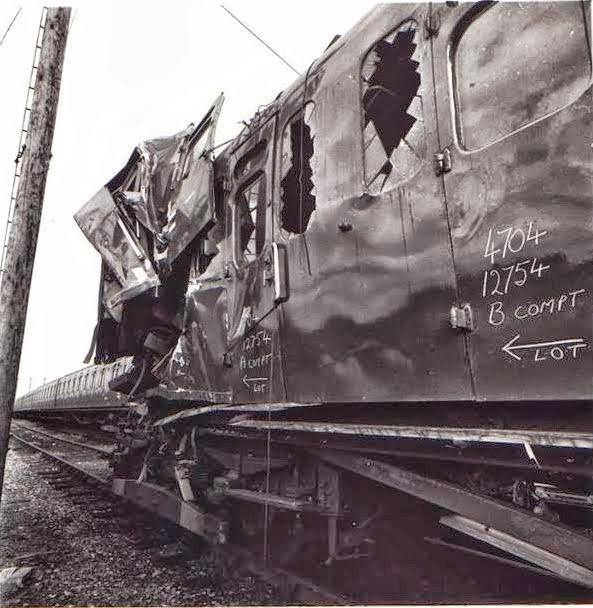
PHOTOGRAPHER UNKNOWN
As to the Signalling Equipment and Subsequent Test
19. At the time of the accident Senior Technician C. Freemantle was in the mess room at the New Cross Gate relay room. He
confirmed that there was nobody in the relay room and nobody at any of the locations who could have been making adjustments
or alterations that might have caused an irregular illumination of the subsidiary aspect of signal L545. He had not had any
occasion to carry out any modifications or adjustments in the relay room or in the location cupboard prior to the accident.
20. In the signal box at the time of the accident was Mr. R. Bell the New Works Assistant (Construction) of the Chief Signal and
Telecommunications Engineers Department who had been responsible for the installation of the signalling equipment. He was
waiting to test a new panel when he was told that an accident had occurred. He immediately crossed to the panel where he saw
that a route had been set from Signal L552 to Signal L536 on the reversible line and that 2H27 had passed along the route and
was occupying track circuits WF & WG, the white route lights had been extinguished in rear of the train but were still
illuminated beyond the train to the exit from the route. The arrows beside the reversible line on the diagram were illuminated to
indicate that an up train was signalled denoting that the locking was still effective for an up train. On staff warning light was
also illuminated on the panel again indicating that the route was locked for an up train. He also saw that track circuit UU was
occupied on the down spur and the train describer berth in that line at Signal L545 was displaying th code 5D33. He explained
that these indications were what he would have expected to see if an up train was proceeding on to the reversible line with a
train waiting at Signal L545 on the down spur line. The detection of the points showed correctly No.966 reverse and No. 965
normal. The panel indications for signals L543 and L545 were showing red, the subsidiary signals were not repeated as being
illuminated, and everything seemed in order except that there was no movement.
21. He told me that shortly after the accident every button was pulled in order to stop al traffic and that as soon as all train
movement had ceased he attempted to call a route from Signal L545 onto No.1 carriage road using the exit button at Signal
L1567 with track circuit WF & WG occupied because the wreckage was still in position; he did not expect to set the route and
was unable to do so. All the cables feeding Signal L545 were disconnected, their insulation resistance tested, and the lamp
voltages of the red aspects of Signals L543 and L545 were taken as well as ensuring that they were properly illuminated. There
was no damage to signalling equipment as a result of the collision and after the wreckage had been completely cleared he set a
route from Signal L552 to L536 and confirmed that with it set but not occupied it was impossible to obtain a route by pressing
the entrance button at Signal L545 followed by the exit button at Signal L1567. He then simulated the passage of 2H27 by the
sequential occupation and clearance of the track circuits from the berth track circuit of Signal L552 (PB) as far as track circuit
WF. After each simulated movement of 2H27 he attempted to set the route for the empty coaching stock train from Signal L545
to the carriage sidings but was not at any time able to do so except on the clearance of track circuits WF. He also checked the
approach locking of Signal L552 which was maintained until the 2 minute time delay had operated. He checked the interlocking
by setting routes from Signal L537 to both the full and restricted overlaps of Signal L545 and attempting to set a route from
Signal L552 to Signal L536; he found that it was impossible using the full overlap but that he could do so using the restricted
overlap although no change of aspect occurred in Signal L537 until the berth track circuit (US) to that signal had been occupied
for 15 seconds in accordance with the locking to make sure that the driver of a train proceeding on the down spur line with the
overlap of signal L545 restricted brings his train under control. He also checked the converse and arranged for the relays
controlling the subsidiary aspect of Signal L545 to be tested; no mechanical or electrical irregularities were found in them
which could have caused the signal to be irregularly illuminated.
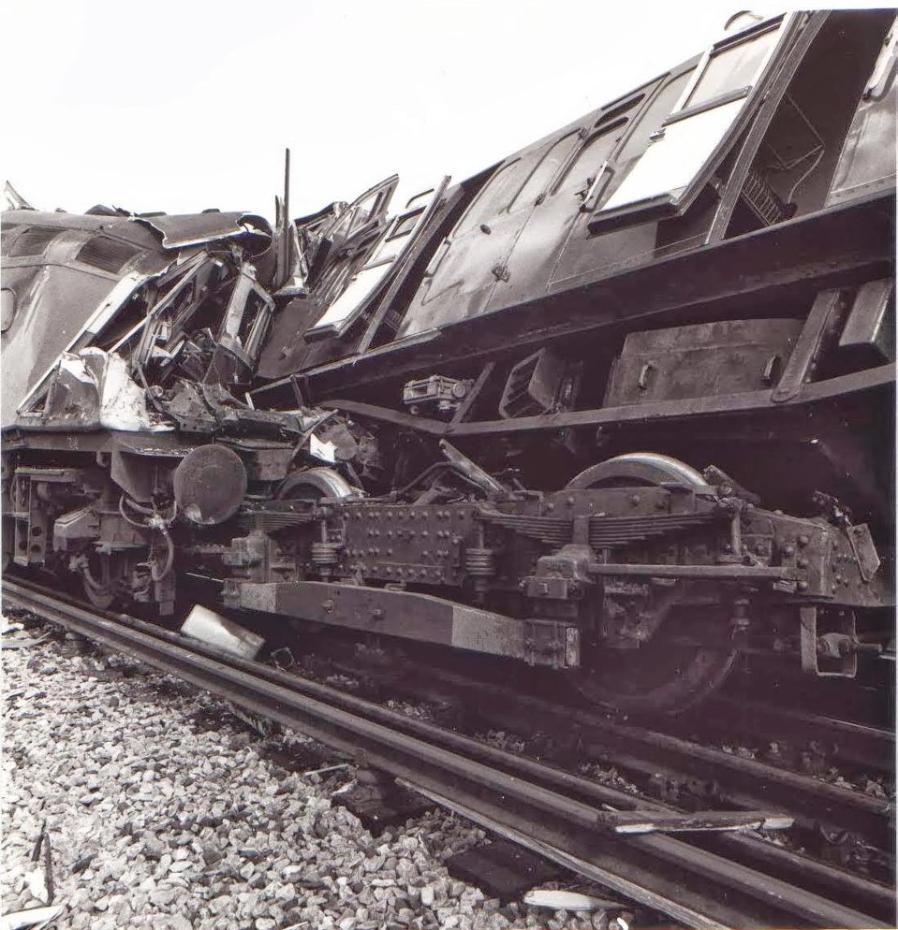
PHOTOGRAPHER UNKNOWN
22. Mr. Bell described the operation of the train describer equipment which, although not part of the safety signalling, is
operated by it. He told me that if a route had been set for 5D33 from Signal L545 to Signal L1567 and the empty coaching stock
train had occupied correctly the overlap of the signal proceeded, the train description would have been extinguished from the
berth of Signal L545 as the train entered the sidings. For the train description to be removed from the panel the route relay
forward from the signal must be energised and the track circuit in advance of the signal must be occupied. If the rate relay is not
energised and the track circuit in advance occupied, the train description remains in the berth of the signal which is what had
happened at Signal L545 on the panel after the collision. He told me that if the subsidiary aspect of Signal L545 had been
illuminated the occupation of track circuit WF would have been extinguished it. He thought than it might have been possible for
an inexperienced signalman to confuse the two overlap buttons at Signal L545 when setting the route from Signal L537 to
L545, but if the signalman had pressed the full overlap button and a route had already been set for 2H27 there would have been
no reaction nor would there have been for the converse. The cable tests included those between the relay room and the location,
and the location and signal head for the main signal, the route indicator, and the subsidiary signal, there were no signs of low
insulation resistance or any other faults. In his tests he had covered all the possible faults which might have resulted in the
irregular illumination of the subsidiary aspect of signal L%$% and he was quite satisfied that there was now ay in which this
could have happened.
23. Mr. Bell was in the signal box some 2 to 3 weeks after the new signalling had been commissioned when the driver of a train
stopped at Signal L1559, telephoned the signalman, and complained that the signal was at danger and that points No.973
immediately beyond it were standing open. This signal is one of two subsidiary signals which must first clear before the
subsidiary aspect of signal L545 can be illuminated. His first assumption was that the points might have moved after the train
had entered the route but he carried out tests to prove that the points were operating satisfactorily. The only other conclusion
was that the driver of the train had passed the subsidiary the main aspects of Signal L545 at danger with points No.973 not
detected reverse and fortunately come to a stand when he saw signal L1559 at danger. This was his personal deduction because
the driver had not made any comment about any other signals and the incident had occured late in the evening when direct
sunshine from the sun low in the sky behind the driver might have cause the subsidiary signal L545 to appear to be illuminated
and the driver had on good faith passed it. As a result he asked for extended hoods and back plated to be fitted to the subsidiary
Signals L543 and L545. On Friday 22nd August he was in the signal box and overheard a driver telephoning one of the
signalmen to ask if the subsidiary Signal L545 was OFF or not. This incident occurred in the morning and as a result of it he
expedited the changes to the hoods and the backgrounds of the two subsidiary signals which were completed before 11th
September. He said that on two or three occasions drivers had telephoned the signalman asking if other position light signals in
the New Cross Gate area were ON or not, but in all cases before the collision, apart from the one in which he assumed the driver
must have passed the signal at danger, the drivers had telephoned whilst standing at the signal.
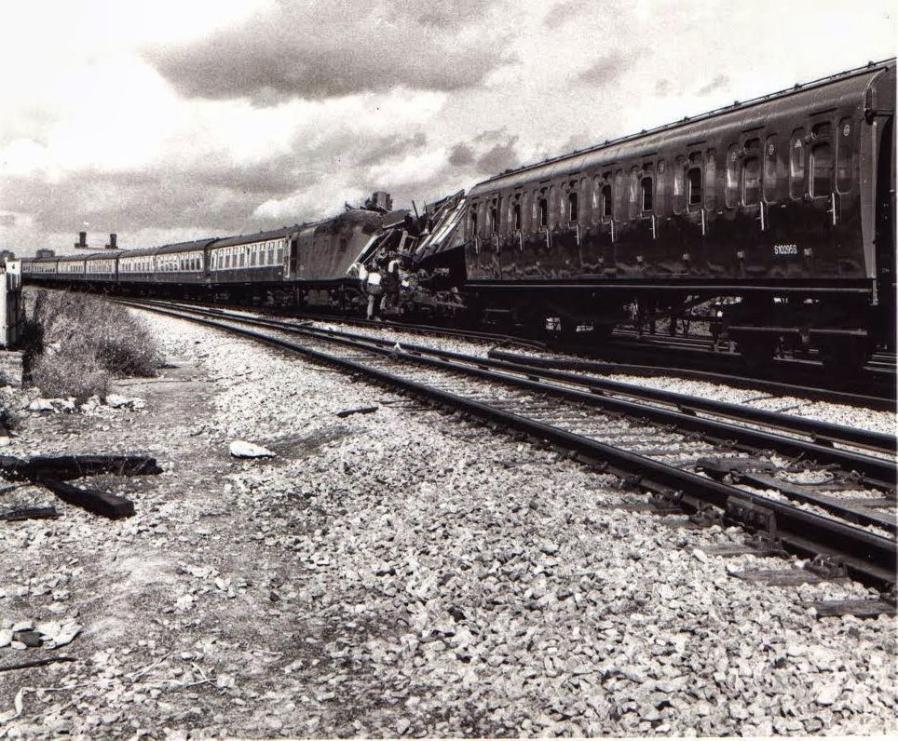
PHOTOGRAPHER UNKNOWN
24. On Saturday 13th September, two days after the accident, using a Class 33 locomotive that was rather cleaner than the one
involved, he took part in tests carried out to investigate the possibility of reflections at Signal L545 on the down spur line.
Previously direct sunlight from immediately behind the train had caused reflections from position light signals but this could not
have been the cause on 11th September when the sun was shining on the front of the locomotive. The locomotive was driven
along the down spur line and approached the signal extremely slowly; about 50 yards in rear of it the locomotive was stopped
and then moved a few yards at a time towards the signal. The test took place at the same time of ay as had the accident and it
was again a bright sunny day. Mr. Bell told me that he was in the cab to see if light was reflected from within the position light
subsidiary signal L545 and that as they drew close to it a phantom indication became apparent; the positioning of the
locomotive was extremely critical and after moving backwards and forwards he managed to establish a strong phantom in the
subsidiary signal which he estimated to be 60 per cent of the properly illuminated brilliance. The phantom was at its greatest
intensity when observed either by looking out of the driver’s window or standing in the doorway on the driver’s side. Viewed
through the secondments or driver’s windscreen it was less strong but the signal was extremely difficult to see because the sun
was immediately behind it and it was necessary to shade the eyes because viewing through the windscreen was not as clear as
looking was not as clear as looking out of the window or door.
25. He went on to the signal gantry during the tests to establish from what part of the locomotive the reflection was arising and
found that it appeared to be coming from the yellow roof panels and the yellow paint of the upper part of the locomotive above
the windscreen. He arranged for the signal to be cleared when the locomotive was in the most critical position and there was no
doubt that the proper illumination was much brighter although of course a driver did not have the advantage of the comparison.
He agreed that the improvements that he had carried out to the signal because of the complaints received would not have been
effective against sunlight being reflected from the locomotive into th signal and then from the signal, resulting in an apparent
illumination, particularly as there was a critical position for the locomotive. Mr. Bell also told me that, until further action could
be taken and because the positioning of the locomotive for getting the intensive reflection was about 15-20ft from the base of
the signal depending on the angle of the sun, a stencil type route indicator had been provided since the accident, mounted above
the position light signal, which must be illuminated at the same time in order to authorise a movement. The stencil indicator is
proof against the phantom and has a 60W bulb to make it a powerful indication. At the end of Mr. Bell’s evidence I asked the
Assistant Signal and Telecommunications Engineer (Works) Mr. V. Brown of the Southern Region for his comments and he said
he was satisfied that the test had been carried out correctly and established that the signalling equipment was correctly installed
and operating properly.
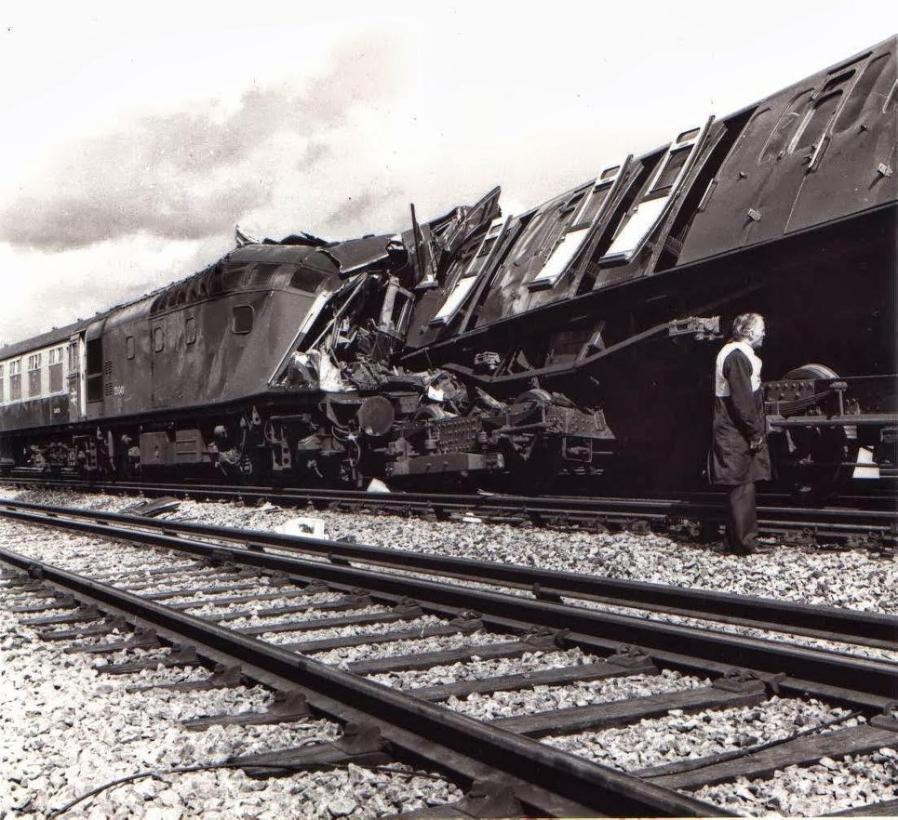
PHOTOGRAPHER UNKNOWN
Tests
26. Some days after the incident, on another bright sunny morning, I travelled on the locomotive hauling 5D33 and attempted to
reproduce the alleged apparent illumination of the position light subsidiary signal L545, described by Mr. Bell in his evidence,
by positioning the locomotive so the maximum amount of sunlight was reflected by the paintwork above the windscreen onto
the signal. I found that with the front wheels of the locomotive 15 feet from the signal, there appeared to be lights in the white
aspects. From the secondments side the upper aspect had bands of illumination from the centre towards the 1 o’clock and 8
o’clock positions, but the lower aspect was not apparently illuminated. From the driver’s door and wind screen there appeared to
be bands illuminated in the upper aspect from the 9 o’clock position to the 3 o’clock position and in the lower aspect from the
centre to the 2 o’clock and 10 o’clock positions. From these tests, allowing for the change in the sun’s elevation, a slight time
difference, and having seen photographs taken during the tests on 13th September 1976 it was clear that under certain limiting
conditions an illumination of this position light signal could be produced by external light, although it was not as bright as the
proper illumination of the aspects.
27. The position light signal concerned is a Westinghouse Westlyte type to BR Specification No.922A. Similar signals with
different lens systems meeting this specification and made by other manufacturers are used on BR. It was fitted with a 40W
lamp behind each white aspect. After the accident the position light Signal L545 was dismantled and found to be assembled in
accordance with the manufactures current drawings. The signals were initially catalogued in two different forms; one for
mounting on an overhead gantry with a hood over each spect of a minimum 6 inch length, to be viewed from below; and the
other for ground mounting to be viewed from above. In 1969, as a result of representations that the optical performance was
unsatisfactory and phantom illumination was possible, the two different forms were discontinued and that which had been used
for ground mounting was adopted and appears in the catalogue now as “suitable for mounting on gantries or near ground level”.
This change was possible because the only major difference between the two forms was in the assembly of the lenses and filters.
After the accident, tests were carried out with the position light signal both ground and gantry mounted using a mirror to
produce reflected lighted. The effect of the way in which the lens was assembled on the signals’ tendency to apparent
illumination could be clearly seen. With the lens assembled in the manner laid down for ground mounting prior to 1969 and
subsequently adopted as standard and the signal placed on a gantry, reflection from below could be made to produce a clear
phantom illumination. However, with the lens assembled in the manner laid down for gantry mounting prior to 1969 and the
signal and mirror in the same positions, the phantom illumination disappeared.
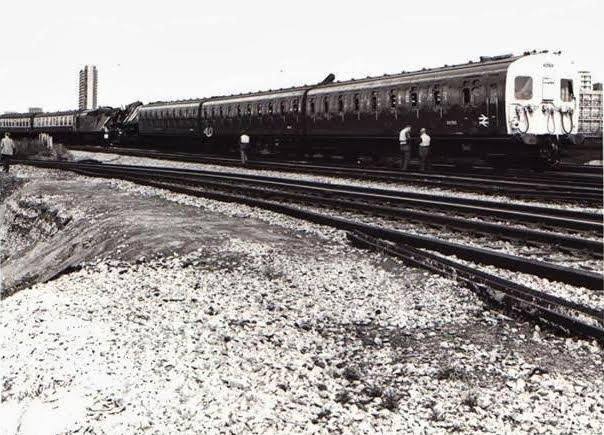
PHOTOGRAPHER UNKNOWN
Discussion
28. All the tests carried out on the safety interlocking and signalling equipment show that it was designed, installed, and
operating properly and the evidence shows that the two trains were correctly signalled. However the investigations carried out
on the possibility of the irregular illumination, through reflected light, of the position subsidiary signal L545 have shown that
this could occur and that the way in which the lens system was assembled would have increased the strength of any such
illumination. The locomotive crew, knowing that their booked route required the illumination of the subsidiary signal,
approached signal L545 at danger with the sun behind it and did not keep it under continuous observation. The final movement
of the locomotive coming to a stand and that of the sun whilst the train was stationary were probably sufficient to allow the
reflection from the front of the locomotive to intensify the apparent illumination of the subsidiary signal to a level at which it
attracted the secondman’s attention. Both the driver and secondman initially expressed doubts about the illumination of the
signal but they viewed it from two different positions within the locomotive cab, moving to obtain a good view because the sun
was behind the signal. Both men were obviously satisfied that the aspects were illuminated although not in the same way as
other position light signals that they had seen. It must be remembered that the signalling was newly commissioned and that they
did not have the benefit of being able to compare the illumination with a reference, as did those taking part in the tests
afterwards.
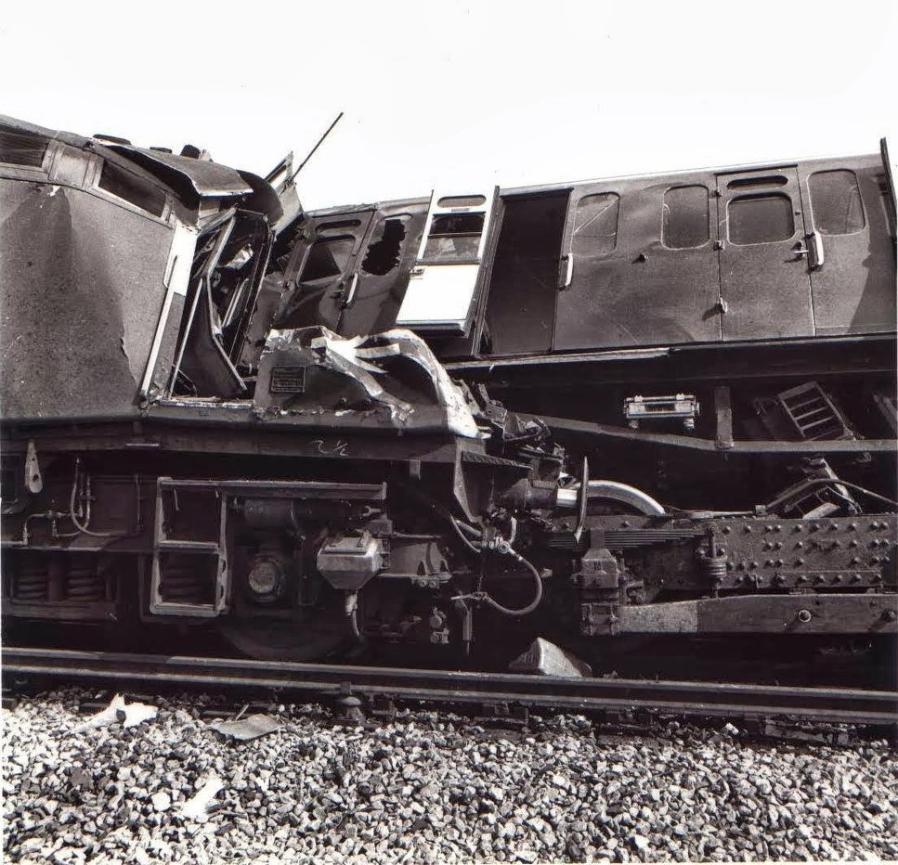
PHOTOGRAPHER UNKNOWN
Conclusion
29. I conclude that an apparent illumination of the position light subsidiary aspect of signal L545, occurred through a
combination of the alignment of the line, the optical system of the lens, and reflection of the sun’s rays from the surface of the
locomotive standing at the signal. The collision then took place because Driver Park, observing the illumination and having
satisfied himself that a proceed aspect was exhibited, drove 5D33 past the signal, which in fact was still at danger, into the route
of 2H27.
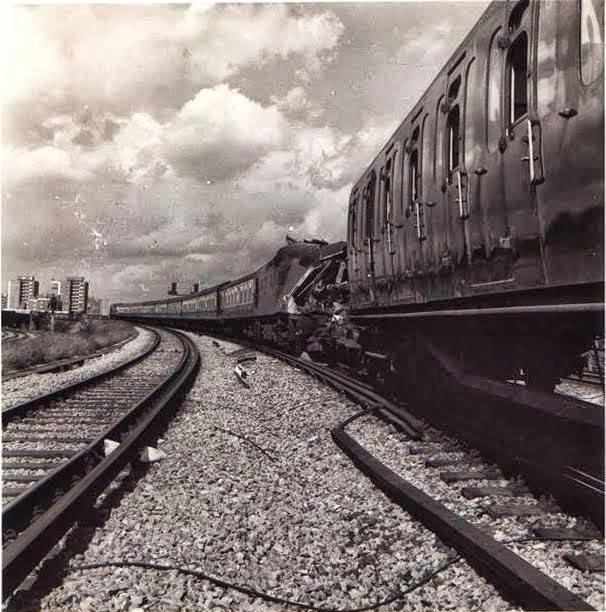
PHOTOGRAPHER UNKNOWN
Remarks
30. I have discussed the reasoning which led to the decision in 1969 referred to in paragraph 27 with Mr. R. Martin the Quality
Assurance Manager of the Signal and Mining Equipment division of the Westinghouse Brake and Signal Company Ltd., and
with Mr. A.A. Cardani the Chief Signal and Telecommunications Engineers of the British Railways Board. They very kindly
allowed me to see the correspondence relating the change and I have been provided with diagrams showing two different
methods of assembling a lens and the way in which exterior light falling upon its surface might be reflected. The designer of a
signal this type has to strike a comprise between intensity of illumination for the driver and the need to avoid apparent
illumination by reflection of exterior light; allowing for the position of the signal, the angle at which it is set, and the need to
provide a good view of the driver of a locomotive standing close to the signal. It is clear that the decision to provide only one
type of position light signal, suitable for mounting on gantries or near ground level, was only taken after considerable discussion
and some research. The possibility of light originating from outside below the horizontal axis of the lens and causing a phantom
illumination was considered but was felt to be mostly unlikely. In the circumstances I feel that the decision was taken only after
proper thought and that although with hindsight it might now be considered as having been unwise, the particular way in which
the external light was directed at the signal with the sun behind it deepening the shade in which this signal lay, only came about
through a very rare combination of circumstances which I do not think could have been detected during the exhaustive checking
before commissioning of the new installation at London Bridge.
31. I do not think that Driver Park can be held responsible for the collision because, having approached and stopped at the signal
at danger. I do not believe that he would have driven his train past it unless he was sure that the position light subsidiary signal
was displaying a proceed aspect. I consider that both he and his secondman took care to satisfy themselves that the signal had
cleared by their action in moving within the cab to observe the signal better against the sun.
32. Ian assured by the Officers of British Railways that they have reverted to the two different forms of signal provided by this
manufacturer prior to 1969 with the firms agreement and that, after a thorough check, position light signals now have the lens
system assembled according to the elevation of the signal. Where difficulties have arisen over sunlight, hoods are being
provided.
33. I am told that the optical performance of current position light signals is not completely satisfactory and that an improved
design of lens has been developed that will not require adjustment according to the elevation of the signal and which minimises
the risk of phantom indications. I have not been told that existing instructions, which have been brought to the attention of all
concerned, make it quite clear how the lens is to be assembled in current design and that should this type of signal be ordered in
the future it will be specified whether it is required for gantry or ground mounting so that there can be no doubt as to the correct
positioning of the lens.
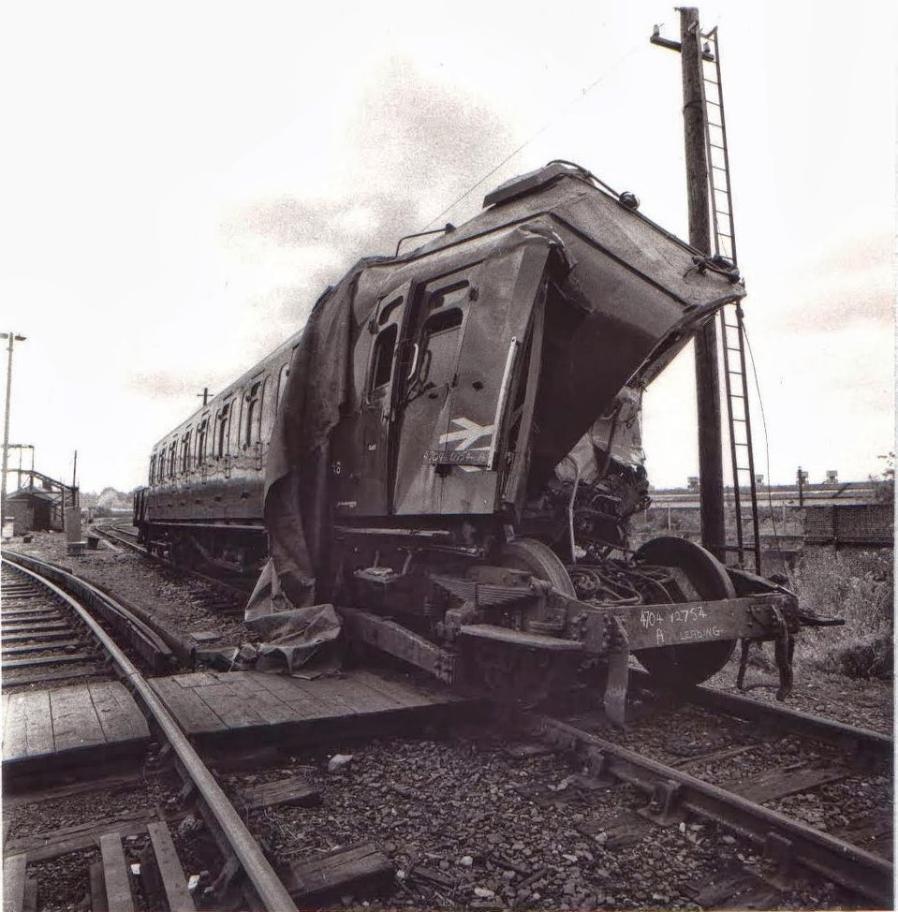
PHOTOGRAPHER UNKNOWN

